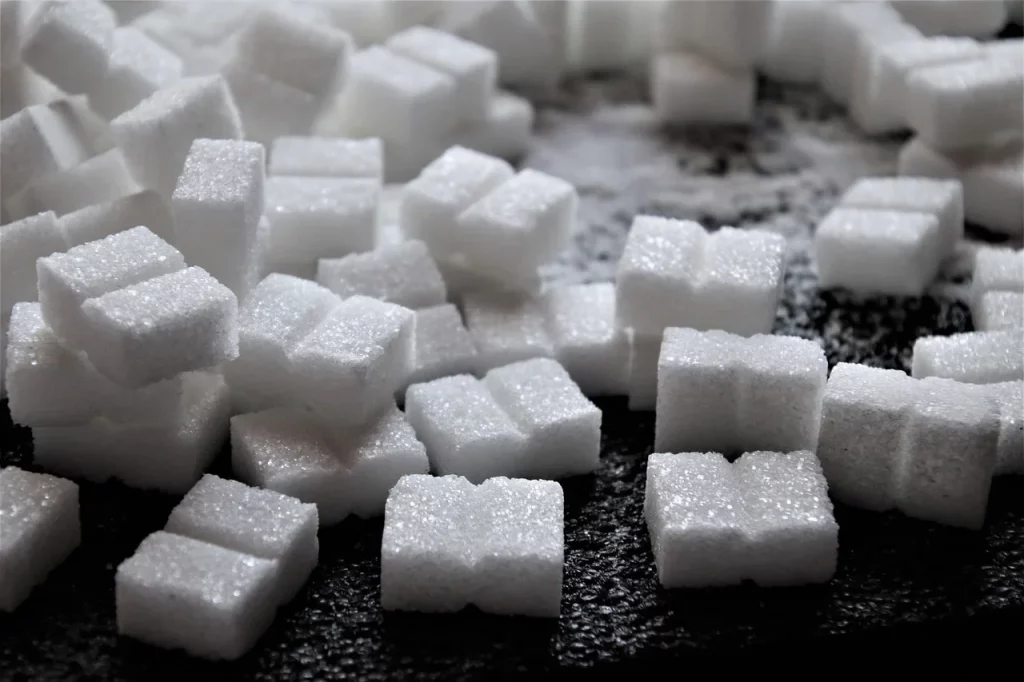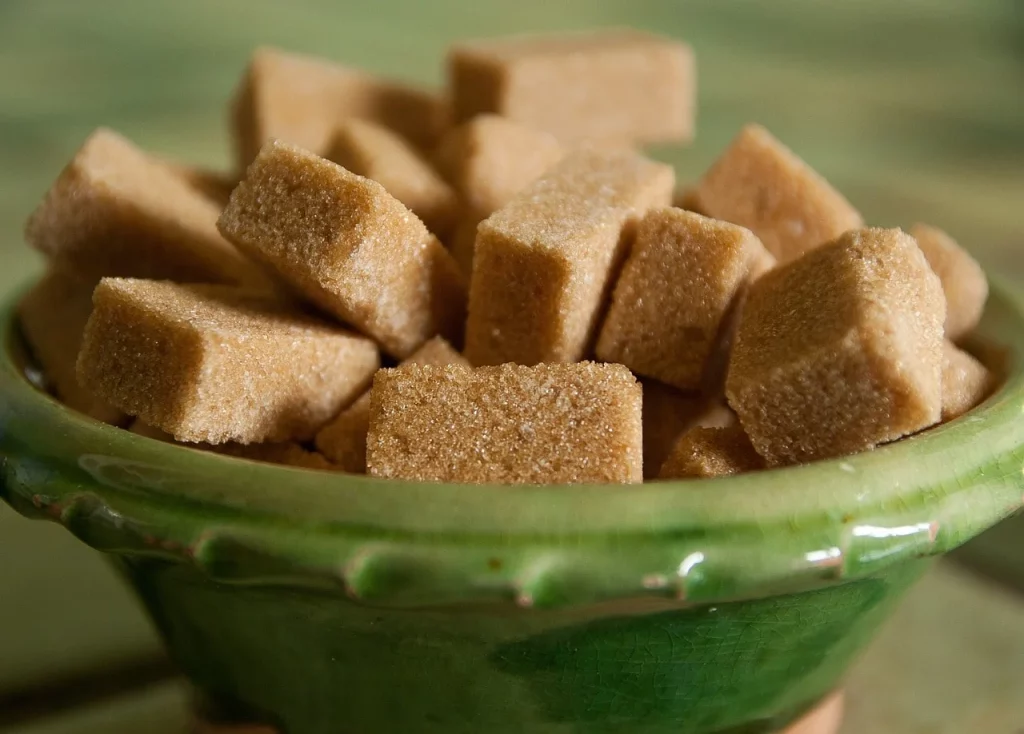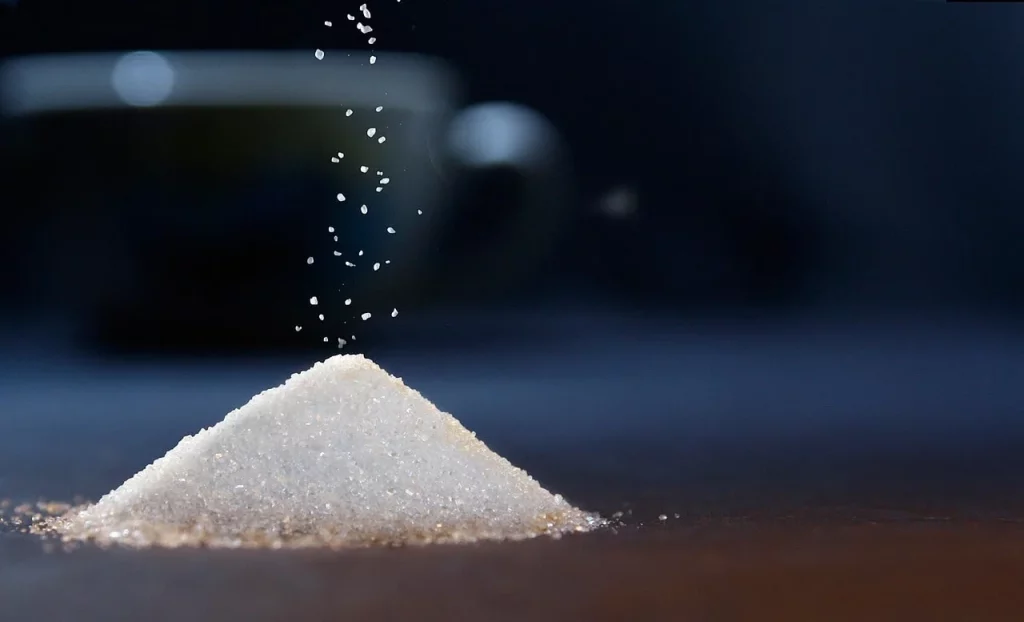Sugar, often seen as a mere ingredient in our desserts, actually holds a universe of facts that span history, science, and health. It’s a protagonist in many of our daily rituals, yet how deeply do we understand its essence and implications?
This journey through some fascinating sugar facts aims to peel back the layers of this ubiquitous substance, offering insights that range from its historical significance to its influence on global health trends. As we explore the multifaceted world of sugar, you might find yourself questioning, appreciating, and even reevaluating your sweet encounters.
Life is uncertain. Eat dessert first.
Ernestine Ulmer
Sugar Facts
Dive into the sweet world of sugar with me, and don’t miss the quiz I created for you at the end of this article. Read carefully to prove your expertise. Don’t disappoint me.
- The taste buds on the human tongue have a specific receptor designed to detect sweet flavors, aiding in the identification of energy-dense foods.
- In medieval Europe, sugar was once so expensive that it was primarily consumed by the affluent.
- The main sources for extracting sugar are beet and sugarcane plants, with sugarcane contributing to around 80% of global sugar production.
- Persian scholars in the 9th century were the first to chemically isolate sugar.
- Brazil stands as the top producer of sugarcane, making it the globe’s foremost sugar supplier.
- As a preservative, sugar inhibits bacterial growth, thereby extending the shelf life of foods.
- The concept of a “sugar rush” is a myth; sugar does not actually cause hyperactivity in children.
- Excessive consumption of sugar may lead to non-alcoholic fatty liver disease (NAFLD), impacting liver function.
- Blackstrap molasses, a by-product of refining sugar, is packed with essential nutrients.
- During the 18th century, sugar overtook grains in value, becoming the most lucrative item in European trade.
- All sugars and starches are broken down into glucose by the body, serving as a vital energy source.
- Artificial sweeteners were developed to help those with diabetes or those monitoring their caloric intake enjoy sweetness without the sugar.
- The world’s most ancient piece of chewing gum, over 5,000 years old, was made from birch bark tar with a sweet flavor.

- An increased risk of heart disease has been linked to high sugar consumption, affecting even those who are not overweight.
- Before sugar became widely available, honey was the predominant sweetener.
- Refined sugar was traditionally produced and sold in shapes called “sugar loaves,” a term that described its cone-like form.
- Since ancient times, sugar has been utilized in medicine, including for its wound-healing properties.
- Jakub Krystof Rad invented the first sugar cube in 1843, changing the way sugar was consumed and sold.
- Fructose, found in fruits, is processed by the liver and doesn’t spike insulin levels.
- Photosynthesis in plants produces sucrose, also known as table sugar, from sunlight.
- India pioneered the techniques for extracting and purifying sugar.
- Insulin resistance, a precursor to diabetes, can result from consuming too much sugar.
- The word “sugar” comes from the Sanskrit “śarkarā,” which means “ground or candied sugar.”
- A teaspoon of sugar contains around 16 calories.
- The sugar industry saw significant growth during the Industrial Revolution, thanks to technological advances in production.
- Sugar sculptures, known as subtleties, were elaborate displays of wealth at medieval feasts.
- Eating high-sugar foods can lead to a spike in energy, followed by a quick decline, often called a “sugar crash.”
- Indians around 350 AD made the breakthrough in sugar refining technology.

- High sugar intake has been associated with an increased likelihood of developing certain cancers, such as pancreatic cancer.
- Approximately 75% of all packaged foods in supermarkets contain added sugar.
- The Glycemic Index (GI) rates how quickly foods raise blood sugar, with sugar having a high index value.
- Maple syrup is made by boiling the sap from sugar maple trees, a less common source of sugar.
- Caramelization is when sugar browns upon heating, a technique used to add flavor and color in cooking.
- Sugar was a key element in the Triangular Trade, being traded for slaves and merchandise between the 16th and 18th centuries.
- The 19th century saw the creation of granulated sugar, making sugar easier to use in households, especially for baking.
- The link between sugar and the obesity epidemic is strong, with high consumption correlating to increased obesity rates.
- A substance called Miraculin changes sour tastes to sweet tastes and is used in “miracle berry” products.
- The earliest candies were made from honey, fruits, and nuts before the widespread availability of sugar.

- Some researchers believe sugar addiction is real, given sugar’s impact on the brain’s reward pathways.
- In the Caribbean, slaves once used “sugar cuts” as a form of trade.
- Molasses, a thick, sweet syrup derived during sugar refining, is a staple in baking and rum production.
- In the past, cavities were sometimes filled with sugar, before the detrimental effects on dental health were understood.
- Global sugar consumption is on the rise, with an average intake of about 24 kilograms per person annually.
- A high-sugar diet can disrupt the gut’s bacterial balance, leading to gastrointestinal issues.
- The crystallization process is crucial for producing solid sugar from syrup.
- Sugarcane, a tall perennial grass, is among the largest crop sources for sugar.
- Sugar art involves crafting decorative pieces from sugar for dessert embellishments.
- Barbados was dubbed “The Sugar Island” in the 17th century due to its dominant sugar production.
- Research indicates that sugar consumption may impact memory and learning abilities.
- The brain requires a significant amount of sugar energy to function, consuming about half of the body’s sugar intake.
Sugar Myths

After reading all these fun facts about sugar, it’s time to move on to the next section. Here, we are going to separate the truth from the myth.
- Sugar Causes Diabetes
Diabetes is not caused directly by sugar consumption. It’s more complicated than that. Type 2 diabetes is often related to obesity and physical inactivity. However, excessive sugar intake can lead to weight gain, which increases the risk of developing diabetes. - All Sugars Are the Same
Not all sugars are created equal. Naturally occurring sugars, found in fruits and dairy, come with nutrients and fiber. Added sugars, on the other hand, provide empty calories without essential nutrients. The body’s response to these can vary. - Sugar Is Addictive Like Drugs
Although frequently claimed, sugar has not been conclusively proven to be addictive in the same way as drugs. Cravings for sugar are real, but they don’t equate to true addiction. Psychological factors often play a significant role. - Cutting Out Sugar Completely Is Healthy
Completely eliminating sugar from your diet isn’t necessary for good health. Moderation is key. A balanced diet can include small amounts of sugar, especially from natural sources like fruits, which provide essential nutrients alongside sugars. - Sugar Causes Hyperactivity in Children
Despite popular belief, research has not supported the idea that sugar causes hyperactivity in children. Factors such as the environment and context of sugar consumption may influence behavior more than sugar itself.
No products found.
Sugar Quotes

Let’s continue to the next section. Below, you will find a list of my favorite quotes. Feel free to share yours in the comments so I can add them to the list as well.
Sugar is sweet and so are you.
Traditional Saying
This traditional saying uses sugar as a metaphor to express affection and sweetness towards someone, highlighting their pleasant nature.
I can resist everything except temptation.
Oscar Wilde
Oscar Wilde humorously admits his inability to resist the allure of temptations, including, implicitly, the sweetness of sugar.
If you’re going to sin, sin against God, not the bureaucracy; God will forgive you but the bureaucracy won’t.
Hyman Rickover
Hyman Rickover cheekily suggests that divine forgiveness is more accessible than bureaucratic leniency, possibly referencing the “sin” of indulging in sugar amidst health and regulatory warnings.
A balanced diet is a cookie in each hand.
Barbara Johnson
Barbara Johnson’s quote playfully redefines the idea of a balanced diet, promoting a lighthearted approach to enjoying sweets like cookies liberally.
Let them eat cake.
Attributed to Marie Antoinette (though historically disputed)
This famous phrase, often attributed to Marie Antoinette, symbolizes disconnect and indulgence, suggesting a frivolous attitude towards the luxury of sweets amidst broader societal needs.
Sugar FAQ

Before you reach the next section, you first have to read the answers to some common questions. Read carefully if you want to ace the upcoming quiz.
- Can sugar cause headaches?
Yes, sugar can indeed lead to headaches for some people. When you consume sugar, your blood sugar levels spike, and your body releases insulin to bring it down. This rapid rise and fall can trigger headaches in some individuals, especially those who are sensitive to changes in their blood sugar levels. - Are sugar rushes real?
The idea of a “sugar rush” — a burst of energy following the consumption of sweets — is popular, but scientifically, it’s a bit more complex. Research suggests that while sugar can temporarily increase energy by providing an easily accessible source of calories, it doesn’t necessarily cause the hyperactivity often associated with a “sugar rush.” - Which sugar is the healthiest?
When it comes to health, not all sugars are created equal. Natural sugars found in fruits (fructose) and dairy products (lactose) are generally considered healthier options because they come with vitamins, minerals, and fiber in the case of fruits. Among added sugars, less processed forms like honey, maple syrup, and agave nectar might retain more nutrients compared to white table sugar (sucrose) or high fructose corn syrup. - How does sugar affect the brain?
Sugar has a significant impact on the brain. Consuming sugar releases dopamine, a neurotransmitter associated with the pleasure center of the brain, which is why eating sugary foods can feel rewarding. However, overconsumption can lead to reduced sensitivity to dopamine, requiring more sugar to achieve the same pleasure effect, which can contribute to overeating and weight gain. - Will sugar dissolve in water?
Yes, sugar dissolves in water. When sugar is added to water, the water molecules interact with the sugar molecules and break them apart, dispersing them throughout the solution. This process, known as dissolution, occurs more rapidly with stirring, higher water temperatures, or finer sugar granules (like powdered sugar) due to the increased surface area and improved water molecule interaction.
No products found.
Sugar Trivia

Welcome to the Sweetest Quiz on Earth: A Sugar Saga! Fail to answer, and you might find your kitchen invaded by an army of cookie dough soldiers demanding you learn their sweet secrets.
Conclusion
Sugar, much like a double-edged sword, offers us sweetness and energy but demands our respect in return. Its role in our diets and cultures cannot be overstated, weaving a narrative that is both delightful and cautionary.
As we’ve explored the multifaceted aspects of sugar, from its health implications to its economic impact, it’s evident that our relationship with sugar is as complex as it is sweet. Let’s carry forward the knowledge we’ve gained, using it to make informed choices about our consumption.


